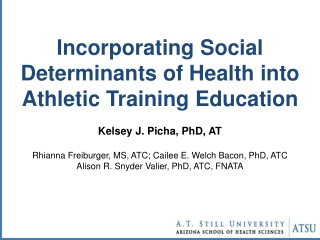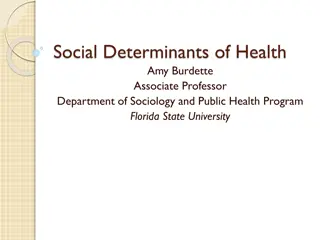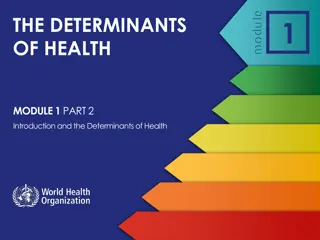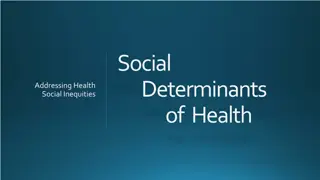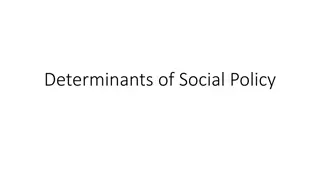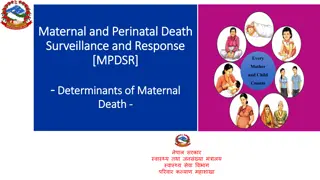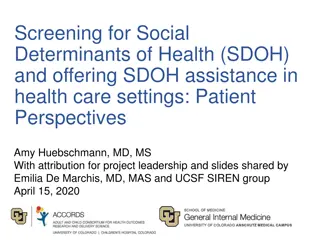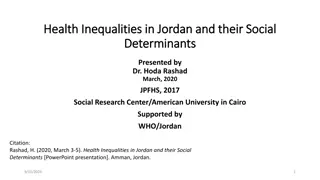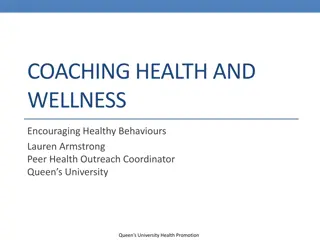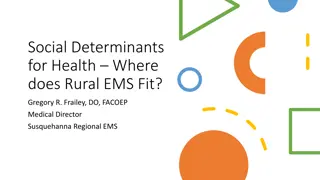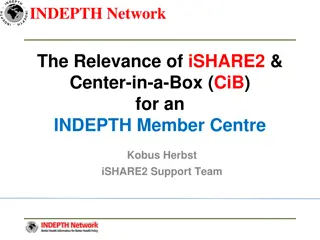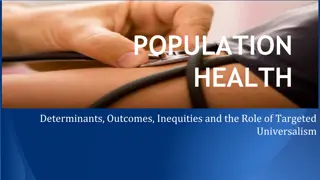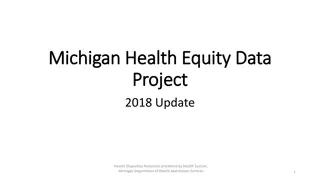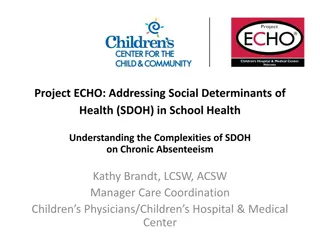Importance of Collecting Standardized Social Determinants of Health Data
Health centers are focusing on collecting standardized social determinants of health (SDOH) data to address the needs of individual patients and promote social justice. This systematic approach involves gathering qualitative data for every patient, structured data via screening tools, and standardized data using codes like ICD-10 z-codes. Stakeholders are being equipped with the motivation and knowledge to leverage this data for improving healthcare outcomes.
Download Presentation

Please find below an Image/Link to download the presentation.
The content on the website is provided AS IS for your information and personal use only. It may not be sold, licensed, or shared on other websites without obtaining consent from the author.If you encounter any issues during the download, it is possible that the publisher has removed the file from their server.
You are allowed to download the files provided on this website for personal or commercial use, subject to the condition that they are used lawfully. All files are the property of their respective owners.
The content on the website is provided AS IS for your information and personal use only. It may not be sold, licensed, or shared on other websites without obtaining consent from the author.
E N D
Presentation Transcript
Why Collect Standardized Data on Social Determinants of Health? March 2017
To equip health center stakeholders with the motivation, knowledge, and ability needed to collect and use standardized social determinants of health data Goal
Why Collect Standardized SDOH Data? The Triple S Payment reform, policy change, and research ICD-10 z-codes Tools and Next Steps Contents
Health Centers and SDOH Health centers have long recognized the importance of acting on SDOH for individual patients Collecting structured, standardized, SDOH data is a return to health center social justice roots Physical Environment 10% Clinical Care 20% Social & Economic Factors 40% Health Behaviors 30%
Renewed focus and momentum on SDOH Centers for Medicare and Medicaid Services National Academy of Medicine Institute for Healthcare Improvement Department of Health and Human Services, Office of the Surgeon General
The Triple S for SDOH Data Systematic SDOH data Example: Notes in the patient chart on SDOH needs collected during all encounters with population of focus Structured SDOH data Example: Data collected via a screening tool and entered into EHR using homegrown codes Standardized SDOH data Example: Data collected and coded using a standard dataset (e.g., ICD-10 z-codes) and aggregated across health centers
Systematic SDOH data Data are collected for every patient (in the population of focus) but are qualitative Systematic data support: Patient-level Referral to resources Direct service Provider and patient satisfaction that SDOH needs are being addressed
Structured SDOH data Structured data are defined, organized and can be compiled Structured data support: Panel-level Example: VA Homeless Patient Aligned Care Teams are half the size of other primary care panels. Matching workforce to patient population needs Program and partnership priorities
Standardized SDOH data Standardized data use a common set of definitions and codes for aggregation across data sources (e.g., multiple health centers, payers) Standardized data support: Research on what works for whom Predictive analytics Negotiating for risk-adjusted payment
SDOH data landscape Screening and referrals for SDOH Systematic SDOH data Structured SDOH data Using SDOH data for population health and panel management Research on interventions to address SDOH in clinical settings Standardized SDOH data Using SDOH data across health centers to inform payment and policy
Applications for standardized SDOH data Data collected and coded in a systematic, structured, standardized way support: Payment Reform Policy Change
Payment Reform Adapt value-based care models to reflect the underlying reality that medical and social acuity influence intensiveness of care and health outcomes Health centers could request adjustment to payment based on SDOH Pay for Performance Care Management Payments Capitation Contracts
Payment Reform Pay-for-performance contracts Most health centers have P4P with their plans Example: P4P for preventable ED visits Payment - adjust performance expectation/requirement based on social factors where there is a conceptual and evidence-based link to outcomes* *National Quality Forum. Risk Adjustment for Socioeconomic Status or Other Sociodemographic Factors: Technical Report. August 15, 2014.
Payment Reform Care management payments Many states pay supplemental Medicaid Health Home payments for care management and coordination Medicare has recently introduced a care management and coordination payment (CPT 99490, 99487, 99489) Example: NY state Health Homes adjusts per member per month (PMPM) payments by an acuity score which acounts for SDOH such as incarceration, homelessness, and interpersonal violence
Payment Reform Capitation contracts Current Medicaid rate setting does not take social acuity into account There is a case to be built for SDOH risk adjustment, the same way rates are adjusted for age, sex, & disability Example: MassHealth (Medicaid in Massachusetts) is proposing risk adjusting Managed Care Organizations/Accountable Care Organizations global capitation rates based on select social factors
Policy Change - Prevention Policy change requires standardized data To address SDOH through prevention Example: E-codes reflect patient injury data collected by hospitals 1991: recommendation that external cause of injury be included in discharge data This led to policy change: Mandates for pool & firearm safety
Policy Change Equity To help safety-net have sufficient resources and protections to create equity in outcomes
Research Research requires standardized data that can be aggregated across many health centers To understand what works for whom Example: Hypoglycemia increases toward the end of the month when patients run out of food stamps* *Seligman HK, Bolger AF, Guzman D, L pez A, Bibbins-Domingo K. Exhaustion of food budgets at month's end and hospital admissions for hypoglycemia. Health Aff (Millwood). 2014 Jan; 33(1):116-23. PMID: 24395943; PMCID: PMC4215698.
How should we standardize? Example ICD-10 Z-codes ICD-10 Z-codes are one option Already exists! Allows aggregation across systems Already an EHR field Dataset is already used by payers Homelessness Z59.0 Underachievement in school Z55.3 Unemployment Z56.0 Lack of adequate food Z59.4 Problems related to release from prison Z65.2
Caveats to ICD-10 Not all SDOH domains have ICD-10 Z-codes First choice for documentation would be another standardized dataset. Interim dataset may be needed Example SDOH Domains without z-code Transportation Refugee status Farmworker status
Multi-Domain SDOH Screening Tools There is a list of screening tools on the Social Interventions Research & Evaluation Network (SIREN) at the University of California, San Francisco website Including: PRAPARE IOM Recommended Social and Behavioral Domains and Measures for EHR WE CARE
Documentation in EHR Build for systematic, structured, ideally standardized data collection Some templates have been developed Example: PRAPARE has templates for Centricity, NextGen, Epic, eClinicalWorks Of these, Centricity, NextGen, and Epic are linked to ICD-10 Z-codes
Whats Next? Considerations for leveraging standardized SDOH data for value-based payment Do you have performance payments linked to outcomes that are affected by social factors? Does Medicaid in your state have a Health Homes program? Do any of your payers pay care management fees? Could you partner with your managed care plan and/or associated ACO on making a case for rates adjusted for social factors? Work with your PCA, HCCN, or consortia
Whats Next? Conduct further analytics using SDOH data to explore research questions and influence policy Which social determinants interventions have the greatest impact on health outcomes? When in the life course to intervene? Develop in-house analytics and/or consider a research partner
Resources HITEQ Value-Based Payment Resources PRAPARE Toolkit AAPCHO Enabling Services Accountability Project Social Interventions Research & Evaluation Network (SIREN) at the University of California, San Francisco
Questions? Feedback? Email: hiteqinfo@jsi.com Phone: 1-844-305-7440 This project is/was supported by the Health Resources and Services Administration (HRSA) of the U.S. Department of Health and Human Services (HHS) under cooperative agreement U30CS29366 Training and Technical Assistance National Cooperative Agreement for $1,954,318. This information or content and conclusions are those of the author and should not be construed as the official position or policy of, nor should any endorsements be inferred by HRSA, HHS, or the U.S. Government.


